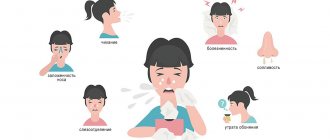Difficulty breathing and lack of nasal discharge are contradictory symptoms indicating that you are experiencing nasal congestion without a runny nose. As a rule, this uncomfortable condition is also accompanied by the following symptoms: lacrimation, pain in the facial area, sneezing and itching in the nasal cavity.
This problem significantly reduces the quality of life: the brain experiences oxygen starvation (respiratory hypoxia), increased fatigue is observed, endurance and performance decrease, and the quality of sleep also deteriorates, which negatively affects the nervous system.
After reading this article, you will learn the main causes of the problem, ways to diagnose the disease and understand how to treat nasal congestion without a runny nose.
Causes of nasal congestion without a runny nose
Difficulty breathing without other symptoms may have one of the following causes:
- Initial stage of the disease.
The respiratory tract is damaged by pathogenic bacteria; symptoms are temporarily absent. - Allergies
are the body’s immune response to dust, flowering plants, food, and animal fur. - Dusty and dry air.
- Violation of the shape of the nasal septum
is a congenital feature of the nose or acquired as a result of mechanical trauma. - Polyps
are benign neoplasms that form as a result of frequent colds, inflammation of the nasopharynx, allergic rhinitis, excessive consumption of alcoholic beverages, smoking, and the anatomical features of the structure of the nasal cavity. - A foreign object in the nose
causes pain and discomfort, sneezing and watery eyes. - Hormonal disorders
often occur in teenage girls, in women during pregnancy and on the eve of menopause - this condition does not threaten health. - The result of using medications.
For example, difficulty breathing due to repeated and prolonged use of vasoconstrictor drops or individual intolerance to the drug. - Rhinopharyngitis
is inflammation of the nasal passages, lymph nodes, the secreted secretion flows down the back wall of the patient’s throat, the nose remains dry. - Inflammatory processes of the nasal mucosa (different types of sinusitis, frontal sinusitis).
Swelling and purulent discharge block air access. - Oncological diseases of the brain and nasal canals
are a life-threatening health condition. The person may feel soreness, nausea, dizziness and weakness.
If you suspect cancer, you need to see a doctor (oncologist) and undergo a comprehensive examination.
List of sources
- Karpova E. P., Vagina E. E. Irrigation therapy in pediatric rhinology // Issues of modern pediatrics: scientific and practical journal of the Union of Pediatricians of Russia. 2009, vol. 8, no. 5, pp. 115–118.
- Bogomilsky M.R., Chistyakova V.R. Pediatric otorhinolaryngology. M.: GEOTAR-Media, 2012; 176:222.
- Zaplatnikov A.L. Topical decongestants in pediatric practice: safety and clinical effectiveness // Pediatrics. 2006. No. 6. P. 69-75.
- Radtsig E.Yu., Bogomilsky M.R., Laberko E.L., Ermilova N.V. The relationship between age-related features of the structure of the nasal mucosa and methods of administering drugs for the treatment of acute infectious rhinitis in children and adolescents. Pediatrics. 2012; 91 (4): 83-88.
- Ryazantsev S.V. Modern decongestants in the complex therapy of acute and chronic diseases of the ENT organs. Russian otorhinolaryngology. 2005. No. 6 (19).
Why is nasal breathing difficult for a child?
Not only adults, but also children face the above problem. Factors of nasal congestion in babies:
- Young children have narrow nasal passages and sometimes little oxygen is supplied, so they often breathe through their mouths;
- the mucous membrane is relatively dry, accumulations of dried secretions are the causes of nasal congestion and are observed in children from two years of age.
Common factors causing difficulty in nasal breathing in children are various types of inflammation of the mucous membrane, as well as foreign bodies (buttons, pieces of food, small parts from toys).
Prevention
Prevention of nasal congestion comes down to a number of general measures:
- Hardening the child (contrast water procedures).
- Do not allow the child to become hypothermic.
- Avoiding contact with various types of irritants (dust, tobacco smoke, gas).
- For frequent nasal congestion, rhinitis, and acute respiratory infections, in order to increase local immunity, take the immunostimulating agent IRS19 (for children over 3 years of age).
Diagnosis of nasal congestion
There is a large list of serious diseases that can be signaled by nasal congestion without a runny nose. Be careful with self-medication; first of all, we recommend that you consult a qualified specialist.
Home diagnostic methods depend on the specific disease.
| Symptoms, method of diagnosis | Disease |
| If after using vasoconstrictor drops there is no relief in breathing within 15 minutes | Drug-induced rhinitis |
| Difficulty breathing in one nostril. Lie on your side, after 15 minutes turn over to the other side. The congestion of the nostril (the one located above) does not go away, one-sided difficulty breathing is observed | Trauma, abnormal septum, or presence of a foreign object |
| Nasal congestion, swelling of the nasopharynx, weakness and high temperature | Infectious rhinitis |
| Difficulty breathing, sneezing, pain in the eyes, if a person enters a certain room, upon contact with certain substances | Allergic reaction |
| Vasoconstrictor drops have no effect, headache | Polyp formation |
| Difficulty breathing without ARVI symptoms in adolescent girls, pregnant women and women on the eve of menopause | Vasomotor rhinitis |
| Dry cough and inflammation of the throat mucosa without a runny nose | Sore throat, pharyngitis and other inflammatory diseases |
| Inhalation is accompanied by whistling, unpleasant sensations of sore throat, change in voice | Posterior rhinitis |
| Difficulty breathing is accompanied by shortness of breath, swelling, cough, headaches | Diseases of the cardiovascular system |
| Mouth breathing in infants, loud snoring | Physiological feature of newborns |
Other diagnostic methods require test results, so they must be carried out under the supervision of a specialist. Even if the cause of difficulty breathing has been established independently, the assumption must be confirmed by an ENT specialist. Otherwise, incorrect therapy can lead to a serious deterioration in the patient’s condition.
When contacting an ENT specialist, you will conduct a comprehensive examination, allowing you to determine the cause of the disease with a high degree of probability. At the first appointment, the patient is examined using an endoscope to detect foreign bodies in the nasal passages.
Then the doctor can prescribe laboratory tests - various tests, smears, bacteriological culture. After analyzing all the results, the ENT specialist will make a diagnosis. If necessary, additional ultrasound and x-rays are prescribed.
Treatment
Often, patients believe that nasal congestion without a runny nose will go away on its own and do not consult a doctor. Meanwhile, difficulty breathing gets worse.
Drug therapy
First of all, the doctor prescribes drops to moisturize the mucous membrane and produce natural lubrication, as well as local ointments and creams to ease breathing. The ENT doctor then prescribes topical corticosteroids to relieve mucosal swelling and congestion.
In addition to local hydration, it is necessary to drink more fluid to allow water to flow through the blood vessels, instill saline solution, or rinse the nose with a solution of salt or sea water. You need to normalize the moisture level in the room and ventilate the room more often. Thus, local mucosal immunity will recover faster.
Hormonal and antibacterial local drugs are used only after identifying the cause of difficulty breathing. Corticosteroid-based products are contraindicated in children and are prescribed only to adult patients with chronic congestion.
If the cause of congestion is an allergy, then second-generation antihistamines are prescribed. Depending on the degree of difficulty breathing, tablet form or nasal drops are used.
Breathing exercises
Sometimes nasal congestion without a runny nose appears due to addiction to vasoconstrictors. In this case, it is recommended to completely abandon this group of drugs and practice breathing. You should clear your nasal passages, then try to take a full breath and exhale slowly through both nostrils. The exercise is done several times a day, every day. Over time, breathing will resume.
Surgical intervention
Often, during an appointment with an ENT doctor, it turns out that the cause of constant nasal congestion is a deviated septum. In this case, therapeutic treatment is powerless, because the curvature provokes inflammation, irritation and swelling of the mucous membrane. The only true treatment option is septoplasty.
Nasal congestion should not be left untreated, otherwise it can lead to otitis media, sinusitis, laryngitis, pharyngitis and other otorhinolaryngological diseases. An impaired respiratory process causes atrophy of the nasal mucosa.
At the ENT CLINIC in Chertanovo, doctors will always help patients. After a thorough examination and tests, they will determine the cause of difficulty breathing without a runny nose and help the patient regain healthy, full nasal breathing.
What is the danger of constant nasal congestion without a runny nose?
Chronic difficulty breathing through the nose leads to a number of negative changes in the body:
- reduction in the acuity of smell to its complete loss (sometimes without recovery);
headaches (oxygen starvation);- the chronic form of allergic rhinitis can provoke bronchial asthma;
- prolonged difficulty breathing in children can contribute to deterioration of hearing and smell, and cause mental retardation;
- the appearance of night snoring;
- failure in the blood circulation of the brain is a serious threat to life;
- lack of sleep, debilitating weakness, memory impairment, depression, apathy, prolonged nervous tension.
Consequences and complications
Often developing nasal congestion is accompanied by a risk of impairment of the health/well-being and general development of the child, which can manifest itself:
- Frequent headaches.
- Disorders of smell and sensitivity of taste buds.
- Insomnia.
- Inflammation of the mucous membrane of the paranasal sinuses ( sinusitis ) and the Eustachian tube/middle ear ( acute otitis media ).
- The appearance of snoring with the risk of developing apnea (nocturnal cessation of breathing).
- Decreased intellectual abilities (memory, concentration).
Acute rhinitis
Acute rhinitis is one of the most common diseases in childhood. Every mother is familiar with its symptoms: the child’s nose is stuffy, runny nose, etc.
Acute rhinitis has an infectious form, caused by viruses or bacteria. The disease can manifest itself as a separate disease of a viral or bacterial nature or be a component of infectious diseases such as influenza, ARVI, scarlet fever, meningitis, diphtheria, etc.
Provoking factors for acute rhinitis are hypothermia, polluted air, decreased human immunity, allergies, adenoids, and hypertrophic rhinitis. Therefore, if the nose is constantly stuffy, the child clearly has weak immunity, and it needs to be improved!
Symptoms of acute rhinitis:
The disease occurs in 3 stages:
- discomfort in the nose, itching, sneezing, tears, headache, malaise, fever (within 1-2 days);
- the nose is stuffy, it becomes difficult for the patient to breathe, hoarse voice, watery discharge from the nose, decreased sense of smell;
- The nasal discharge becomes thick and purulent, and the patient is bothered by severe nasal congestion.
1 Consultation with an otolaryngologist in MedicCity
2 Consultation with an otolaryngologist in MedicCity
3 Consultation with an otolaryngologist in MedicCity
Allergic rhinitis
Allergic rhinitis is an inflammation of the mucous membranes of the nose, which is based on an allergic reaction of the body to any allergen.
Possible allergens:
- household or book dust;
- dust mite;
- insect bites;
- plants;
- Food;
- medications;
- molds and yeasts.
You can read more detailed information about allergic rhinitis here.
Chronic catarrhal rhinitis
Chronic catarrhal rhinitis is persistent inflammation in the epithelial tissues of the nose, which does not lead to changes in the structure of the nose.
Typically, chronic catarrhal rhinitis appears as a result of an untreated form of acute rhinitis or its advanced form. In the case of an advanced form, pathogenic organisms multiply in the nasal mucosa, causing catarrhal inflammation.
Symptoms of the disease:
- runny nose that appears in autumn and winter;
- mucous or purulent discharge;
- lack of sense of smell (no nose breathing at all);
- headache.
Diagnostics
During an examination, an ENT doctor may detect boils, cracks and eczema in the nasal cavity. During rhinoscopy, mucus in the nasal cavity in the form of a mesh can be noted.
Chronic rhinitis
Chronic rhinitis is a long-term, chronic inflammation of the nasal mucosa, which appears as a result of the negative influence of microbes, as well as some environmental factors (dust, air pollution) on the nasal mucosa.
Types of chronic rhinitis
- allergic (seasonal, allergies to plants and products);
- infectious (occurred as a result of infectious diseases);
- non-allergic, non-infectious rhinitis (medicinal rhinitis, hormonal rhinitis, rhinitis of the elderly).








